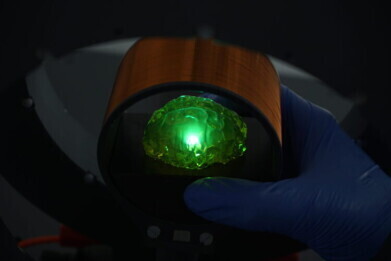-
 Credit: University of St Andrews
Credit: University of St Andrews
Research News
Lighting up the future of healthcare
Mar 12 2024
An international partnership has come up with a new device platform for placing small wireless light sources in the body as a minimally invasive approach for better understanding and treatment of diseases. This could replace implantation of more bulky devices based on the electrical excitability of human cells, such as cochlear implants, cardiac pacemakers and brain stimulators that are already providing life-changing solutions for many individuals.
The novel approach presented by researchers from the University of St Andrews, Scotland and the University of Cologne, Germany, is based on the integration of organic light-emitting diodes (OLEDs) on acoustic antennas. OLEDs, commonly found in modern smartphones, consist of thin layers of organic materials which can be deposited on almost any surface.
“We have exploited this property to deposit OLEDs directly on the acoustic antenna, thus merging the unique properties of both platforms into a single, extremely compact device” explained Professor Malte Gather, who directed the study.
The new devices operate at the sub-megahertz frequencies, similar to those used in submarine communications, as electromagnetic fields at this frequency are only weakly absorbed by water. However, classical antennas used in radios and smartphones would be too large at this frequency to be used in a medical implant with a much smaller footprint.
Julian Butscher, who developed the new devices as part of his PhD, said, “Unlike a classical antenna, an acoustic antenna can be very small, even when harvesting energy from a low frequency electromagnetic field.”
The wireless light-emitting device targets optical stimulation that has emerged as a promising alternative to electrical stimulation because it can be more cell selective and even enable the stimulation of individual cells via genetic modification. Such techniques have already shown promising results in early clinical trials, for instance, in treating an otherwise untreatable eye disease.
For many emerging applications, multiple sites must be stimulated independently and this is why modern brain stimulators often incorporate a large number of electrodes. By tuning the operation frequency of different acoustic antennas to different values by slightly varying their size, the scientists can operate several of their tiny light bulbs independently, turning each one on and off individually. This carries the future potential for the individual addressing of multiple stimulators in different parts of the body, for instance, to treat debilitating neurological disorders.
With their novel device platform, the scientists now move one step closer to developing the ‘ideal stimulator’ by combining minimal device size, low operation frequency, and optical stimulation.
The research was published in Science Advances
More information online
Digital Edition
International Labmate 49.6 - Sept 2024
September 2024
Chromatography Articles - HPLC gradient validation using non-invasive flowmeters Mass Spectrometry & Spectroscopy Articles - From R&D to QC, making NMR accessible for everyone: Putting NMR...
View all digital editions
Events
Oct 30 2024 Birmingham, UK
Oct 30 2024 Manchester, UK
Nov 11 2024 Dusseldorf, Germany
Nov 12 2024 Cologne, Germany
Nov 12 2024 Tel Aviv, Israel


















